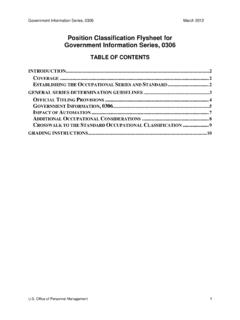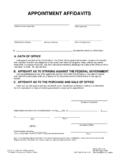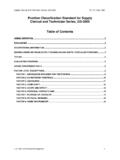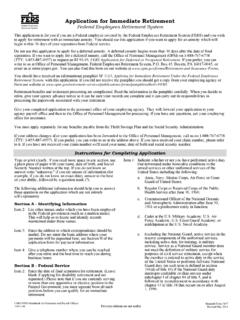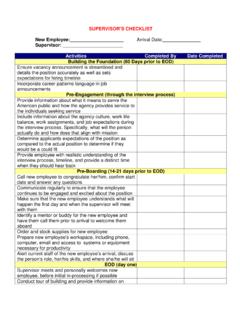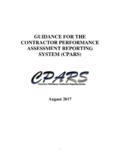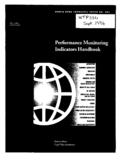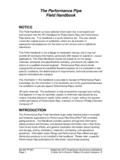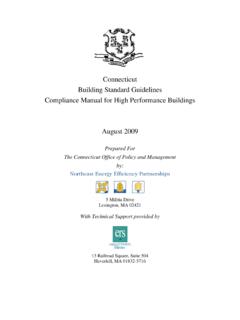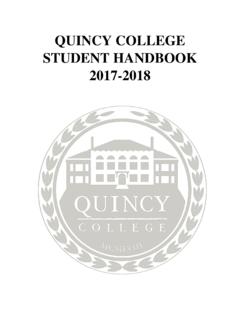Transcription of A Handbook for Measuring Employee Performance - opm.gov
1 U nited States O ffice of Personnel M anagement A Handbook for Measuring Employee Performance MARCH 2017. table of contents FOREWORD .. 2. CHAPTER 1. contents Performance MANAGEMENT: BACKGROUND. AND CONTEXT .. 4. Employee Performance Plans .. 7. CHAPTER 2. DISTINGUISHING ACTIVITIES. FROM ACCOMPLISHMENTS .. 12. The Beekeepers and Their Bees .. 12. Using Balanced Measures .. Categories of Work .. 17. 18. CHAPTER 3. DEVELOPING Employee Performance PLANS .. 20. Step 1: Look at the Overall Picture .. 25. Step 2: Determine Work Unit Accomplishments .. 28. Method A: Goal Cascading Method .. 29. Method B: Customer-Focused Method .. 32. Method C: Work Flow Charting Method.
2 35. Step 3: Determine Individual Accomplishments That Support Work Unit Goals .. 39. Step 4: Convert Expected Accomplishments Into Performance Elements, Indicating Type and Priority .. 43. Step 5: Determine Work Unit and Individual Measures .. 47. Step 6: Develop Work Unit and Individual Standards .. 52. Step 7: Determine How To Monitor Performance .. 61. Step 8: Check the Performance Plan .. 67. Guiding Principles for Performance Measurement .. 68. CHAPTER 4. LEARNING AIDS .. 70. Performance Measurement Quiz .. 70. Quick Reference: The Eight-Step Process .. 72. APPENDIX A: Five-Level Appraisal Examples .. 75. APPENDIX B: Three-Level Appraisal Examples.
3 80. APPENDIX C: Two-Level Appraisal Examples .. 84. A Handbook FOR Measuring Employee Performance 1. foreword T his Handbook is designed for Federal supervisors and employees and presents an eight-step process for developing Employee per- formance plans that are aligned with and support organizational goals. It also provides guidelines for writing Performance elements and standards that not only meet regulatory requirements, but also maximize the capability that Performance plans have for focusing Employee efforts on achieving organizational and group goals. The methods presented here are designed to develop elements and standards that mea- sure Employee and work unit accomplishments rather than to develop other measures that are often used in appraising Performance , such as Measuring behaviors or competencies.
4 Although this Handbook includes a discussion of the importance of balancing measures, the main focus presented here is to measure accomplishments. Consequently, much of the information presented in the first five steps of this eight- step process applies when supervisors and employees want to measure results. However, the material presented in Steps 6 through 8 about developing standards, monitoring Performance , and checking the Performance plan apply to all measurement approaches. 2 A Handbook FOR Measuring Employee Performance . foreword The Handbook has four chapters and three appendices: CHAPTER 1 gives the background and context of Performance management that you will need to understand before beginning the eight-step process.
5 CHAPTER 2 defines accomplishments, which is key to using this Handbook successfully. CHAPTER 3 includes a detailed description of the eight-step process for developing Employee Performance plans that are aligned with and support organizational goals. CHAPTER 4 provides study tools, including a followup quiz and a quick reference for the eight-step process. THE APPENDICES contain example standards that were written specifically for appraisal programs that appraise Performance on elements at five, three, and two levels. After reading the instructional material, studying the examples, and completing the exercises in this book, you should be able to: DEVELOP a Performance plan that aligns individual Performance with organizational goals USE a variety of methods to determine work unit and individual accomplishments DETERMINE the difference between activities and accomplishments EXPLAIN regulatory requirements for Employee Performance plans A Handbook FOR Measuring Employee Performance 3.
6 Chapter 1 chapter 1. P E R F O R M A N C E M A N A G E M E N T: B A C K G R O U N D A N D C O N T E X T. R emember the story about the naive student in his first English literature course who was worried because he didn' t know what prose was? When he found out that prose was ordinary speech, he exclaimed, Wow! I've been speaking prose all my life! . Managing Performance well is like speaking prose. Many managers have been speaking and practicing effective Performance management naturally all their supervisory lives, but don't know it! Some people mistakenly assume that Performance management is concerned only with following regulatory requirements to appraise and rate Performance .
7 Actually, assigning ratings of record is only one part of the overall process (and perhaps the least important part). Performance management is the systematic process of: planning work and setting expectations continually monitoring Performance developing the capacity to perform periodically rating Performance in a summary fashion rewarding good Performance The revisions made in 1995 to the governmentwide Performance appraisal and awards regulations support natural Performance management. Great care was taken to ensure that the requirements those regulations establish would comple- ment and not conflict with the kinds of activities and actions effective managers are practicing as a matter of course.
8 4 A Handbook FOR Measuring Employee Performance . Performance MANAGEMENT: BACKGROUND AND CONTEXT. PLANNING In an effective organization, work is planned out in advance. Planning means setting Performance expectations and goals for groups and individuals to channel their efforts toward achieving organizational objectives. Getting employees involved in the planning process will help them understand the goals of the organization, what needs to be done, why it needs to be done, and how well it should be done. The regulatory requirements for planning employees' Performance include establishing the elements and standards of their Performance appraisal plans.
9 Performance elements and standards should be measurable, understandable, verifiable, equitable, and achievable. Through critical elements, employees are held accountable as individuals for work assignments or responsibilities. Employee Performance plans should be flexible so that they can be adjusted for changing program objectives and work requirements. When used effectively, these plans can be beneficial working documents that are discussed often, and not merely paper work that is filed in a drawer and seen only when ratings of record are required. MONITORING In an effective organization, assignments and projects are moni- tored continually.
10 Monitoring well means consistently Measuring Performance and providing ongoing feedback to employees and work groups on their progress toward reaching their goals. The regulatory requirements for monitoring Performance include conducting prog- ress reviews with employees where their Performance is compared against their ele- ments and standards. Ongoing monitoring provides the supervisor the opportunity to check how well employees are meeting predetermined standards and to make changes to unrealistic or problematic standards. By monitoring continually, supervi- sors can identify unacceptable Performance at any time during the appraisal period and provide assistance to address such Performance rather than wait until the end of the period when summary rating levels are assigned.
